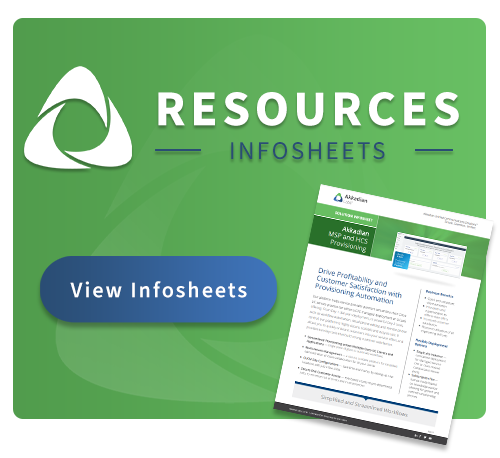Contact centers are investing heavily in AI, omnichannel platforms, and cloud infrastructure. But manual provisioning creates deployment bottlenecks that prevent organizations from capitalizing on these investments. While technology vendors promise rapid implementation, the reality is that agents wait weeks for access to new tools, while competitors race ahead.
Automated UC provisioning eliminates these deployment barriers by ensuring rapid, secure access to new platforms and tools. Rather than wrestling with complex manual configurations, organizations can deploy contact center innovations quickly while maintaining security and compliance standards.
This blog examines the five contact center trends defining 2025 and reveals how automated provisioning turns deployment challenges into key advantages.
RELATED: The Top 5 UC Automation Trends to Watch in 2025
The 5 Contact Center Trends Defining 2025
Trend 1: AI-Powered Agent Assistance
AI tools are transforming agent performance with real-time coaching, automated call summaries, and intelligent routing capabilities. These platforms analyze conversations in real-time, suggest optimal responses, and provide instant feedback that helps improve customer interactions. Organizations that implement AI assistance experience significant improvements in first-call resolution rates and reductions in average handle times.
READ MORE: How AI is Impacting the World of Unified Communications (UC)
The deployment challenge? Each AI platform requires specific UC integrations, unique security configurations, and precise permission sets. Manual provisioning teams struggle to configure these complex requirements quickly, creating delays that prevent organizations from realizing AI’s benefits while competitors gain market advantages.
Trend 2: Omnichannel Integration
Customers expect seamless experiences across voice, chat, email, social media, and other communication channels. Contact centers must provide agents with unified access to conversation history and customer data, regardless of the channel used. This integration eliminates customer frustration by eliminating the need to repeat information when switching channels and enables agents to provide more personalized service based on a complete interaction history.
This experience requires complex backend orchestration that manual provisioning cannot deliver consistently. Each channel demands specific permissions, security protocols, and data access rights. Without proper automation, omnichannel initiatives become fragmented systems that compromise rather than enhance customer experiences.
Trend 3: Real-Time Analytics
Contact centers increasingly rely on immediate insights to optimize staffing and conversation outcomes. Modern analytics platforms process data continuously, providing actionable intelligence that influences real-time decision-making. These systems can predict call volumes, identify trending issues before they escalate, and automatically adjust resource allocation to maintain service levels. The immediate feedback loop enables managers to make staffing adjustments within minutes rather than waiting for end-of-day reports.
However, call handling platforms require precise data access configurations that align with compliance requirements while enabling operational insights. Manual provisioning creates gaps where critical data remains siloed, limiting the insights that could drive competitive advantage.
Trend 4: Cloud-First Infrastructure
Organizations continue to migrate to cloud-based contact center platforms for scalability, cost efficiency, and rapid deployment. Cloud infrastructure provides the flexibility to scale operations according to demand while integrating advanced capabilities. This approach helps contact centers handle seasonal peaks without over-investing in hardware, deploy new features faster, and maintain business continuity through distributed operations. Cloud platforms also facilitate remote work capabilities that attract and retain top talent in competitive job markets.
But cloud platforms multiply provisioning complexity. Each service requires unique configurations, security settings, and integration parameters that manual approaches struggle to handle at scale. This complexity creates friction that could undermine the agility cloud platforms promise.
Trend 5: Enhanced Security Requirements
Contact centers handle increasingly sensitive customer data while working under stricter regulatory frameworks. Organizations must balance accessibility with security, ensuring agents have necessary access while maintaining comprehensive audit trails and preventing data breaches. Modern security frameworks require zero-trust principles where every access request is verified, all interactions are monitored, and permissions are regularly reviewed and updated. These requirements prevent costly data breaches that result in fines and reputational damage.
This balance requires sophisticated access controls, regular recertification processes, and detailed monitoring capabilities that manual provisioning cannot deliver consistently across complex contact center environments.
How Automated Provisioning Enables Contact Center Innovation
These trends represent significant opportunities, but only for organizations with operational foundations capable of executing them effectively. Here’s how automated provisioning turns promising technologies into actual business results.
Accelerated AI Deployment
Automated provisioning eliminates deployment bottlenecks that delay AI initiatives. When organizations deploy new AI coaching tools or predictive analytics platforms, automated systems instantly configure access rights, integrate security protocols, and establish monitoring capabilities.
This acceleration turns AI investments into immediate operational advantages rather than delayed promises, enabling organizations to gain an edge over their competitors while manual processes create deployment delays.
True Omnichannel Operations
Successful omnichannel implementation depends on seamless backend integration that manual processes cannot deliver. Automated provisioning creates unified access management across all communication channels, ensuring agents have consistent permissions and data access regardless of interaction type.
The result is actual omnichannel capability where agents can easily transition between channels while keeping complete conversation context and customer history.
Unleashed Analytics Capabilities
Analytics platforms require precise data access configurations that balance operational needs with compliance requirements. Automated provisioning ensures analytics tools receive exactly the data access they need while maintaining security boundaries.
This precision enables real-time insights that drive competitive advantage, providing clean, properly configured data that generates actionable intelligence rather than compliance concerns.
Cloud Platform Optimization
Cloud platforms promise scalability, but manual provisioning creates finite bottlenecks that constrain capabilities. Automated provisioning matches cloud scalability by instantly configuring new users, services, and integrations as operations expand or contract.
This alignment enables organizations to capitalize on cloud flexibility rather than being constrained by provisioning limitations, and it supports rapid scaling for peak demand while maintaining security throughout.
Comprehensive Security Management
Modern contact centers need security that adapts to ever-changing operational requirements. Automated provisioning implements role-based access controls that automatically adjust as employees change positions, assume temporary responsibilities, or leave the organization.
This system maintains detailed audit trails that document exactly who accessed what information and when, creating compliance documentation while enabling the operational agility that competitive contact centers require.
Conclusion
The contact center trends reshaping 2025 offer major opportunities for organizations ready to capitalize on them. But these opportunities are unrealized without the foundations capable of executing them effectively. Manual provisioning creates deployment delays, security gaps, and operational complexity, which prevent organizations from capitalizing on their call center investments.
Automated UC provisioning eliminates these constraints, providing the operational agility these trends require. Organizations can deploy AI tools rapidly, enable genuine omnichannel operations, unlock analytics insights, scale cloud services efficiently, and maintain security without sacrificing operational speed. More importantly, automated provisioning ensures your contact center can adapt quickly as trends continue to evolve, prepping your organization to capitalize on future innovations and user behavior.
Don’t let manual provisioning slow down your contact center. Akkadian Provisioning Manager eliminates the deployment bottlenecks that turn promising technology investments into operational headaches. Schedule a demonstration to see how our platform can extend your contact center’s capabilities.



